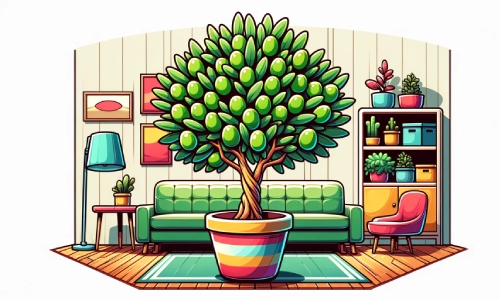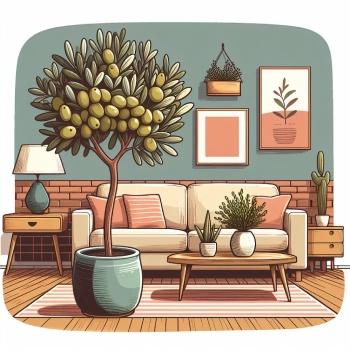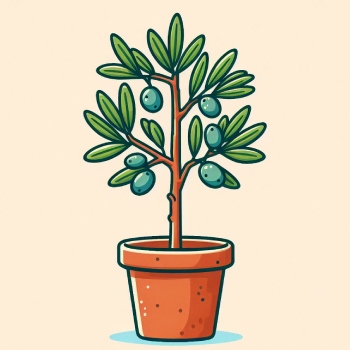Best pots for olive trees

Olive trees are increasingly popular in container gardening due to their beauty and versatility. They're also popular with urban gardeneners - who doesn't love a full-on indoor tree?!
But while they're a fun inclusion for an urban garden, they require a fair bit of space and some serious though. Choosing the right pot is crucial for the health and vitality of your olive tree, for starters.
The size, material, and drainage of the pot directly impact the tree's growth and root development. Here's how it all works 👇
Advice from the experts 👩🌾
Add a layer of gravel or broken pottery at the bottom of your pot to improve drainage.
Factors to consider when choosing olive tree pots
When selecting pots for your olive trees, it's essential to consider several factors to ensure their health and vitality. We'll get to specific styles and products in a little bit, but for now let's focus on some general guidance.
Size
When selecting a pot size for your olive tree, consider the specific variety you're growing and its expected size at maturity. Dwarf varieties may only reach a few feet in height, while standard olive trees can grow much larger, and might not be suitable for indoor gardens. As a general guideline, choose a pot that is at least 2-3 times larger in diameter than the tree's current root ball to accommodate growth.
Ensure the pot provides enough room for the tree's roots to spread and develop properly, promoting healthy growth and preventing root-bound conditions.
Material
Various materials offer distinct advantages for olive tree pots. Terracotta pots provide excellent breathability, promoting healthy root growth, while plastic pots offer durability and lightweight convenience. Ceramic pots, on the other hand, add aesthetic appeal and are suitable for indoor settings, but may require careful drainage considerations. We've got more on this in the next section.
Drainage
Proper drainage is essential to prevent waterlogging and root rot, which can compromise the health of your olive tree. Ensure the pot has drainage holes at the bottom and consider using a well-draining olive tree soil mix to maintain optimal moisture levels.

Top pot types
After considering the various factors for selecting pots for your olive trees, it's time to explore some top recommendations tailored to your needs.
Terra cotta pots
For olive trees, terra cotta pots offer excellent breathability, promoting healthy root growth and moisture regulation. They're also durable and look great.
When maintaining terra cotta pots, ensure proper drainage and avoid overwatering to prevent waterlogging and root rot. Additionally, protect them from extreme temperature fluctuations to avoid cracking. This shouldn't be a problem for an indoor plant.
Check out some large terra cotta pots we found that could be perfect for olive trees.
Lightweight plastic pots
Plastic pots provide durability and convenience, ideal for olive trees that may need to be moved frequently. They're also a fair bit cheaper than terra cotta or ceramic pots.
When using plastic pots, ensure proper drainage to prevent water buildup, and consider placing saucers underneath to catch excess water.
We've also found some nice large plastic pots to consider.
Ceramic glazed pots
For olive trees in indoor or decorative settings, ceramic glazed pots offer aesthetic appeal and come in various sizes and designs to suit your preferences.
When using ceramic pots, ensure proper drainage by adding gravel or broken pottery shards to the bottom before planting. Additionally, be cautious with watering to prevent waterlogging, as ceramic pots may not breathe as well as other materials.
Here are some stylish large ceramic pots perfect for an olive tree.
Self-watering pots
If you're looking for convenience and water efficiency, self-watering pots are a great option for olive trees. With self-watering pots, you can maintain consistent moisture levels without the risk of overwatering or underwatering. Just be sure to monitor the water reservoir regularly and adjust watering frequency based on your olive tree's needs.
Here are some good self-watering pots options.

Care advice for olive trees in pots
Congratulations on selecting the perfect pots for your olive trees! Now, let's dive into some essential tips to ensure they thrive and flourish in their container environment.
Watering, fertilisation, pruning, and shaping
Proper watering is key to keeping your olive trees happy. Here's what you need to know:
- Water your olive trees deeply and thoroughly, allowing the soil to dry slightly between watering sessions.
- During the growing season, fertilize your olive trees with a balanced fertilizer to provide essential nutrients for healthy growth and fruit production.
- Pruning and shaping your olive trees not only enhance their aesthetic appeal but also promote better airflow and sunlight penetration. Remove dead or diseased branches and shape the tree to encourage a balanced canopy.
Pest and disease prevention
Keeping pests and diseases at bay is crucial for maintaining the health of your olive trees. Here's how to protect them:
- Regularly inspect your olive trees for signs of pests such as olive fruit flies, scale insects, and aphids. Early detection allows for prompt intervention.
- Implement preventive measures such as applying neem oil or insecticidal soap to deter pests without harming beneficial insects.
- Practice good sanitation by removing fallen leaves and debris from around the tree to reduce the risk of fungal diseases such as olive knot and verticillium wilt.
Olive tree varieties for indoor gardens
Not all olive tree varieties are suitable for an urban garden - in fact, many are way too big.
To help, we've rounded up some common varities and included their potential height, ideal pot size and whether or not it's suitable for indoors.
| Olive tree variety | Potential height | Pot size needed | Suitable for indoor garden? |
|---|---|---|---|
| Arbequina | 10-15 feet | 24-36 inch diameter | No |
| Koroneiki | 15-20 feet | 30-48 inch diameter | No |
| Frantoio | 20-30 feet | 36-48 inch diameter | No |
| Leccino | 15-25 feet | 30-48 inch diameter | No |
| Picual | 20-30 feet | 36-48 inch diameter | No |
| Arbosana | 10-15 feet | 24-36 inch diameter | Yes |
| Little Ollie | 3-4 feet | 12-18 inch diameter | Yes |
| Picholine | 10-15 feet | 24-36 inch diameter | No |
And that's that! Check out some related articles below - and happy gardening.
